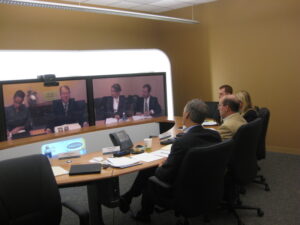TelePresence: video teleconferencing gets real
 Quickly: Cisco’s high-definition video conferencing TelePresence system will change how large companies communicate.
Quickly: Cisco’s high-definition video conferencing TelePresence system will change how large companies communicate.
Last week I avoided a trip to California by having my one-day meeting with Cisco leadership via TelePresence. This is the company’s next generation video conferencing. It features high-definition video, exceptional sound, and specialized rooms with the conferenced individuals “sitting” around a table with the live participants — the pic shows my team in Boxborough MA conversing with John Chamber’s team in San Jose CA. Everyone is life-sized, and the experience is a close emulation of an in-person meeting. Cisco has deployed 240 systems worldwide and has staged 120,000 meetings — for a claimed cost savings and productivity gain of $150 million. The company calculates that it eliminated 24 million cubic feet of carbon emissions as a result.
The system got high grades from our meeting participants. If in-person is 100% and traditional video conferencing is 40%, the attendees put TelePresence at 80%.
Here are the pros:
1) Beautiful experience. Great sound, great video, great environment. Not at all unnatural. Like good surround-sound movie projection systems, the great sound enhances the experience as much as the video.
2) Very natural. If you look at a person, they will see you as looking at them.
3) You get into it. I found myself forgetting that this was video.
4) I’ve always found using traditional video conferencing to be tiring. You have to make an effort to make the meeting work. With TelePresence there was no protocol overhead.
5) At the time, you know you’re on video. In a strange warp, six hours later you remember the meeting as if had been in-person.
6) It’s idiot-proof, or should I say, CEO-proof (they’re probably the same thing).
7) Integration of presentation materials was seamless.
And the cons (…and I know that some of these are nits, but I noticed them):
1) It’s tough to have side conversations — and especially hard to whisper with live attendees.
2) No business card exchange. Sounds stupid, but it was missed. I can never remember who I met with unless I’ve got their coordinates in my pocket.
3) I get a lot of my meeting value with side conversations. When I meet with CEOs I often talk to them “unplugged” as we walk out of the meeting. You can’t do that here.
4) Less bantering, humor, chit-chat — the oil that lubricates most in-person human interaction is missing here.
5) I felt self-conscious eating my lunch on video. High def means that the other side sees all, including the mayonnaise on your upper-lip.
6) Video is a famously “cool” medium — meaning that too much affectation can look ridiculous. When I started waving my arms and shouting out my “brilliant” insight to John Chambers and company I’m sure that I looked somewhat crazed — more so than I would in-person.
7) It’s hard to take notes on your computer — all of that clicking gets picked up by the mics.
Despite my reservations, I think that this technology is a winner. Instead of a box in the corner of a conference room, the system is integrated into the meeting experience so that those on the video get equal treatment with the in-person crowd. It’s expensive ($350,000 of equipment plus $200,000 a year to operate — Verizon’s going to love this baby), but in an age of expensive oil, rising travel costs, and demands to have more meetings in less time, TelePresence could make a big difference for intra-company communication. And with AT&T now in the picture to bridge TelePresence systems between companies there’s more value to come.
Has anyone else out there used the technology? If so, what are your impressions — I’d love to get your thoughts.
